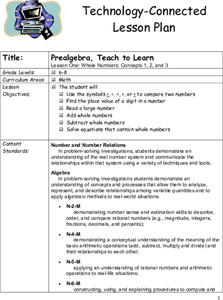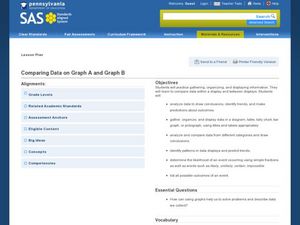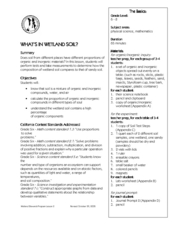Curated OER
Whole Numbers
Student are assigned one of the sections on whole numbers. After reviewing the content, they teach their assigned sections to other class mates. They publish their findings on a PowerPoint slide show to use when they teach their section.
Curated OER
Comparing Data on Graph A and Graph B
Second graders gather and graph data. In this graphing lesson, 2nd graders collect data and graph this information using tally charts, bar graphs, pictographs, or tables. They make predictions about the outcomes.
Pennsylvania Department of Education
Freckle Face
Students collect and record data. In this early data analysis lesson, students gather data about their partners face. As a class, the students use tally marks and pictographs to record the data and answer question about the information...
Curated OER
Math
Learners solve addition, subtraction, multiplication, and division problems that focus on serving size and counting 5 A Day.
Curated OER
Barge Building: What Floats Your Boat?
Students construct aluminum foil boats that float while holding the greatest number of pennies. They investigate the concept of water displacement, record their results, and watch a Bill Nye video on buoyancy.
Curated OER
Conversions: Metrics Made Easy
Students, in groups, measure and record each other's height. They identify measurement conversion methods and use online resources to convert measured heights to multiple systems.
Curated OER
Scaling the Blues
Young scholars identify musical characteristics of blues music and define the term 'scale.' They identify chromatic, major, pentatonic, and blues scales and label each key on a keyboard using letter names, sharps and flats.
Curated OER
Rhythm In Motion
Sixth graders work independently and with a partner to demonstrate proficiency of steady beat, meter and basic note values while creating written rhythmic patterns for class performance. State and National Standards are addressed.
Curated OER
Length Lotto-Teacher's Notes
Students convert metric units of length, specifically meters, centimeters, and millimeters. In this lesson of converting measurements, students participate in various games which require them to put the measurements in order or convert...
Curated OER
Eat Your Veggies
Students investigate displaying data. In this displaying data lesson plan, students use tallies to count data about food preferences. Students use various types of graphs such as bar graphs, picture graphs, box-and-whisker plots, etc...
Curated OER
The Numbers Tell the Story
Students demonstrate how to gather and interpret statistical data. In this data analysis lesson, students search for statistics on the health effects of smoking and place the information into charts. Students create these charts online...
Curated OER
Proportion
Students investigate proportion and ratio. In this geometry instructional activity, students set up the ratios of proportions correctly and solve for the unknown. They relate it to word problems.
Curated OER
Decimal Concepts
Fourth graders complete a journal page to review decimal concepts. For this decimal lesson, 4th graders use manipulatives to represent decimal amounts. Students complete a homework sheet related to decimal and fractional parts.
Curated OER
What's in Wetland Soil?
Students examine the organic and inorganic components of soil. In this environmental science lesson, students identify the factors that influence soil formation. They collect soil samples, conduct tests, and analyze the results.
Other popular searches
- Ordering Comparing Fractions
- Comparing Fractions Game
- Compare Fractions to One Half
- Comparing Fractions Problems
- Compare Fractions and Decimals
- Fractions Comparing
- Fractions Compare and Order
- Fraction Comparison Symbols
- Comparing Fractions to 1/2
- Compare Fractions Decimals
- Fractions Compare of Group
- Comparing Fractions Pictures
















